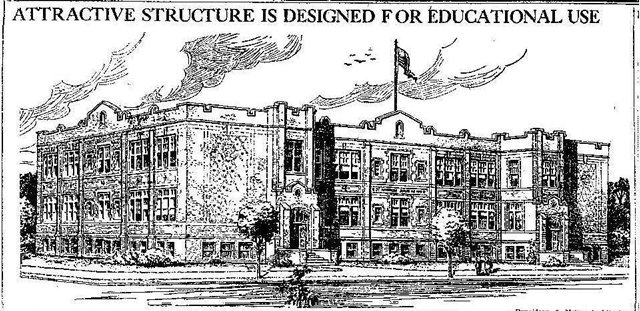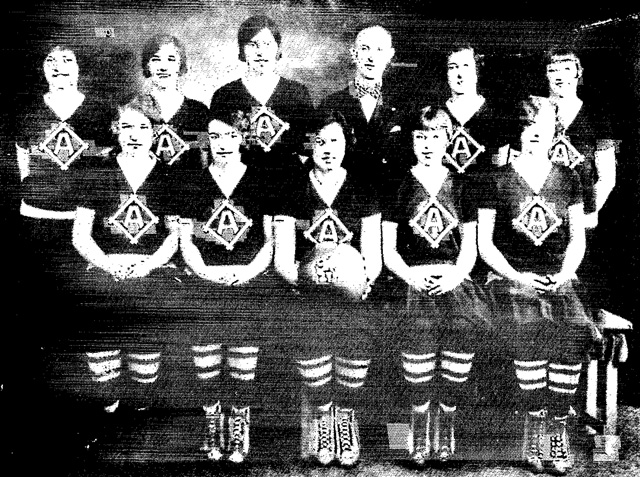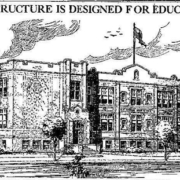Historical Architecture of Grosse Pointe – St. Ambrose School
Last week we explored the lost estate, Deeplands in Grosse Pointe Shores, completed for Henry D. Shelden in 1911. Originally located at 525 Lake Shore and set on a colossal 80 acres, it was one of the largest estates to have ever graced Grosse Pointe. Deeplands was razed in 1947. This week we continue with the story of St. Ambrose Parish, with the story of St. Ambrose School. We recently featured the history of St. Ambrose Church, completed in 1927, having been designed by Detroit based firm Donaldson and Meier – one of several buildings constructed by the firm for St. Ambrose Parish during the twentieth century. You can read the full story of the church by clicking here.
St. Ambrose church was established on September 16, 1916, as a Catholic parish community by Bishop John Foley. At the time a small church, located at Maryland and Hampton Avenue, was constructed to house the few parishioners – the wood framed building was also designed by the firm of Donaldson & Meier. Based on history from stambrosechurch.net, we understand the original church first opened its doors to the community on July 4, 1917.
At the beginning of 1919, St. Ambrose Parish commissioned Donaldson & Meier once again to design its first parochial school, located at 14938 Hampton Avenue. In April 1919, ground was broken on the new parish school that would serve parts of Detroit and the village of Grosse Pointe Park. It is reported the cost to construct the school was approximately $80,000 (around $1.2m today). The facility was designed to be a modern fireproof construction, throughout. An article in the Detroit Free Press (April 27, 1919) explained “the first section of the building would have space for eight classrooms, four music rooms, and a playroom. Provision was made for future expansion that would provide eight additional classrooms.” Image courtesy of the Detroit Free Press (April 27, 1919). The handsome school was constructed from brick and trimmed with stone. The floors and roof were constructed from reinforced concrete. At least eight separate contracts were awarded to contractors to contribute to the building of the school, including the architects Donaldson & Meier. It is reported the school opened its doors in 1920, with 650 grade school students. Three years later, in 1923, a high school department was added. Source: stambrosechurch.net. Image courtesy of: Detroit Free Press (April 27, 1919).

The architectural firm of Donaldson & Meier, founded around 1880, by John M. Donaldson and Henry J. Meier, was well known for their church work in Detroit and southeastern Michigan. Together the duo produced many commissions in the area with much of their earlier work focused on designing churches in the Richardson Romanesque style. However, as architectural styles evolved so did their approach, which is certainly reflected in the Art Deco styled David Stott Building that Donaldson completed in 1929. John Donaldson was born in Scotland in 1854 and immigrated to Detroit with his family as a child. He had a wide and varied architectural education – after graduating from school in Detroit he returned to Europe to study at the Art Academy in Munich, Germany and at the École des Beaux-Arts in Paris. In 1917, his partner Henry J. Meier passed. Donaldson continued to run the firm, he designed at least three buildings in Grosse Pointe, St. Ambrose Church; St. Ambrose Parish School (now razed); and possibly their only residential project in the community 1051 Berkshire, completed in 1929. Like many leading architects in Detroit during the 1920s and 1930’s the firm hired leading sculptors to work on many of their projects.
Aside from being an important educational facility in the area St. Ambrose school, coeducational institute was held in high regard for its athletic teams. It is reported in Heritage magazine (October 1987) “Mother Immaculata, the principal of St. Ambrose High School, believed that sports benefitted girls as well as boys and, as a result, actively fostered girls’ athletics. It was she who hired Mr. Elworthy to coach the girls’ basketball team. Mr. Elworthy was an exacting coach who demanded the best from all his players. In 1928, the St. Ambrose girls’ basketball team gave him what he demanded – that season, they defeated all the teams in the Catholic School League to win the State Catholic School Championship.” On the back of that success, it is reported coach Elworthy then entered the team in a statewide tournament. The team won every game they played and received gold AAU medals as state champions. Image courtesy of: Heritage magazine (October 1987).

The athletic success continued into the 1950’s and 1960’s. We understand St. Ambrose was a Class C school but was a football power in the Detroit Catholic High School League. The team won the Goodfellow Game in 1961, 1962, 1964 and 1966 – The Goodfellow Game was an annual high school football game for the unofficial city of Detroit high school football championship, it was considered one of the state’s most prestigious high school football games of its time. From 1957 to 1967, St. Ambrose produced five football All-Americans and 12 All-State players. Many would go on to play major college football. Two St. Ambrose players played in the National Football League, while two of the coaches would go on to win a combined six Super Bowl rings in the NFL. Source: Wikipedia.
In 1964, St. Ambrose parish hired architectural firm Diehl and Diehl to design a new grade school. Founded by George F. Diehl during the 1920’s, the firm, later run by George’s son Gerald, designed many churches and convents throughout Metro Detroit until the late 1990’s.
In 1972, the St Ambrose high school was closed. Eleven years later, in 1983, the building was razed. The newer grade school continued the traditional parochial education of St. Ambrose through to 2002. It is reported, at that time, governance of the school was transferred from the Archdiocese of Detroit to a Michigan charter school run by National Heritage Academies.
We will be exploring the story of another lost school in Grosse Pointe next week.
*Photos courtesy of the Higbie Maxon Agney archives unless stated.
** Research, information, and data sources are deemed reliable, but accuracy cannot be fully guaranteed.
Written by Katie Doelle
Copyright © 2023 Katie Doelle



